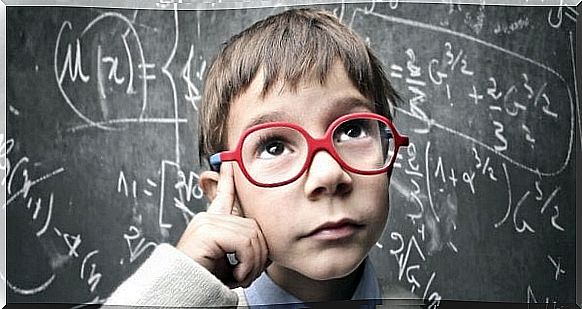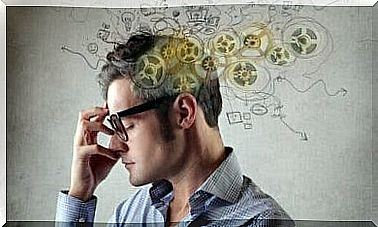Howard Gardner And The Different Types Of Intelligence
For decades, people have believed that intelligence was a single mental function that determines our ability to solve problems, especially in the logical-mathematical realm. But about three decades ago, Howard Gardner questioned this idea. His alternative to this global concept of intelligence was the theory of several different types of intelligence.
Basically, Gardner realized that people did not have a global intelligence that applied to all aspects of their lives. In fact, there were different types of intelligence, which he called multiple intelligences. So recent psychological theories of intelligence have left behind this traditional and probably unfair concept of intelligence.
As we said, it was not long ago that only the logical-mathematical and linguistic parts of intelligence were measured and developed. However, the theory of several different types of intelligence sees cognitive competence as a group of skills, talents and mental abilities called “intelligences”. Moreover, all people have these skills, mental abilities and talents to some degree.
The theory of multiple intelligences sees cognitive competence as a group of skills, talents and mental abilities called “intelligences”.
A definition of intelligence according to Gardner
Academic expertise is not everything
Gardner defines intelligence as “the ability to solve problems or to create products that are valued within one or more cultural frameworks.” First of all, he expands the range of what intelligence is and recognizes what people have always known intuitively.
And it is that some forms of intelligence are related to academic success, but there are others, just as important, that are not. At least not directly, and not in the way intelligence has traditionally been measured.
In fact, the academic factor is usually not the best prediction for how far a person will go. There are people who score very high on traditional intelligence tests but, for example, do not have the slightest bit of skill when it comes to relationships.
Being successful in business or in sports requires intelligence. But we use a different kind of intelligence in every other area. Not a better or worse, just different. To put it another way, Einstein is no more or less intelligent than Michael Jordan . Instead, it’s just that his different types of intelligence fit into other areas.
In fact, it is as this theory of several different types of intelligence advocates that we adapt our teaching methods to each person’s form of intelligence. Adaptation as such will even lower the cost of education (time, resources, energy).
Intelligence is a skill you can develop
Second, and just as important, Gardner defines intelligence as an ability. It was not long ago that people saw intelligence as innate and immutable. You were either born intelligent or not, and your education could do nothing to change that. As a result of this mindset, we did not educate mentally deficient people not so long ago because it was seen as meaningless.
Defining intelligence as a skill means that it is an ability you can develop. Gardner does not deny the genetic component. Instead, he argues that these “potentials” will develop depending on a person’s environment, experiences, education, and so on.
Intelligence is a skill you can develop. As humans, we all have opportunities to increase our intelligence.
No elite athlete gets to the top without training, no matter how good their natural abilities may be. We could say the same thing about mathematicians, poets, or emotionally intelligent people.
Therefore , we all have the potential to develop our intelligence, supported by our abilities and motivation, according to the intelligence model proposed by Howard Gardner.

The theory of several different types of intelligence: 8 kinds of intelligence
Logical-mathematical intelligence
Gardner defines this intelligence as the ability to understand abstract relations. We use it to solve problems in logic and mathematics. It corresponds to the thinking of the logical hemisphere and what our culture has always seen as the only form of intelligence (Morchio, 2004: 4).
According to Gardner (1999a), this intelligence deals with:
- The ability to juggle numbers efficiently
- To analyze problems logically
- To investigate problems scientifically
These people enjoy:
- Solve mysteries
- Work with numbers and complex calculations
- Count
- Organize information into tables
- Fix computers
- Perform brainteasers
- Play computer games
They can also estimate, calculate and remember numbers and statistics (Armstrong, 2003). This is the intelligence of mathematicians, scientists, engineers and logicians (Gardner, 1999a).
Verbal-linguistic intelligence
This is the most recognized intelligence in foreign language learning and teaching. The reason is that it involves reading, writing, listening and speaking (Morchio, 2004).
This intelligence involves having a particular sensitivity to speech and the written language, and the ability to use language is successful in many different areas. It involves being able to use syntax, phonetics, semantics and pragmatic language use (rhetoric, mnemonics, explanation and meta-language) (Morchio, 2004: 4).
People with this kind of intelligence look extremely natural when explaining, teaching or persuading. Why? Because they use language very precisely. According to Armstrong (2003), they like to spend time on:
- Reading
- To tell stories or jokes
- Watch a movie
- Write in a diary
- Create art
- Write poems
- Learn foreign languages
- Play word games
- Examine
Thus, this is the intelligence of lawyers, writers, poets, teachers, comedians, and speakers (Gardner, 1999a).
Musical intelligence
This intelligence includes “the ability to perceive musical forms” (Guzmán & Castro, 2005: 185). It means the ability to easily compose, interpret, transform and evaluate all kinds of music and sounds (Gardner, 1999a).

These people have a “sensitivity to the rhythm, tone and sounds of nature and the environment” (Guzmán & Castro, 2005: 185). According to Armstrong (2003), the people who spend a lot of time on:
- Song
- Listening to music
- Playing instruments
- Go to concerts
- Create music
- Humming while studying
In summary, this is the intelligence for music lovers: composers, singers, sound engineers, musicians, music teachers, etc. (Guzmán & Castro, 2005).
Visual-spatial intelligence
Visual spatial intelligence includes the ability to shape and imagine 2D and 3D images (Armstrong, 2000a). It is also the ability to understand, manipulate, and change the layout of both large and small spaces (Gardner, 1999a).
People whose highest intelligence is visual-spatial find it easier to remember pictures and objects, rather than words. They discover car models, bicycles, clothes and hair (Armstrong, 2003).
These people like to spend time on:
- Drawing
- Doodling
- Painting
- Play computer games
- Low models
- Reading maps
- Study optical illusions and labyrinths.
This is the intelligence of architects, pilots, sailors, chess players, surgeons and artists. It is also the intelligence of painters, graphic artists, and sculptors (Gardner, 1999a).
Body-kinesthetic intelligence
Body-kinesthetic intelligence consists of the ability to use your body (all or just certain parts) to express ideas, learn, solve problems, perform activities, or create products (Gardner, 1999; Morchio, 2004).
They are the kind of people who quickly and easily absorb physical skills. They love to move and play sports. To put it another way, their favorite part of school is sports. (Armstrong, 2003).
They can dance gracefully, act, and imitate the expression and manner of others (Armstrong, 2003). These people think while moving and learn better when they are moving (Armstrong, 2003).
This is the kind of intelligence that is usually very high in athletes, ballerinas, actors, surgeons, craftsmen, inventors, mechanics, and other technical professions (Gardner, 1999).

Interpersonal intelligence
Interpersonal intelligence involves the ability to focus on things that are important to other people. It means remembering the interests, motivations, worldviews, personal history, and intentions of others. It often includes being able to predict their decisions, feelings, and actions (Armstrong, 2003; Gardner, 1993a; 2006).
People who have a naturally high interpersonal intelligence like to talk, learn in groups or couples, and work or do things with people (Armstrong, 2003). They spend a lot of time helping people and volunteering for important causes (Armstrong, 2003). In addition, they are “good social conflict mediators” (Guzmán & Castro, 2005: 187).
They are good communicators because they use both verbal and body language. They have many friends, feel genuine compassion for people and know how to motivate them (Armstrong, 2003) . Therefore, this is the intelligence of teachers, therapists, counselors, politicians, salespeople, and religious leaders (Gardner, 2006).
Naturalistic intelligence
Naturalistic intelligence is defined as sensitivity to natural forms and the geological properties of the earth. It involves the ability to distinguish and classify details and elements in urban, suburban, or landscape environments (Morchio, 2004).
According to Armstrong (2003), these people enjoy:
- Camping
- Hiking
- Taking care of pets
- Learn and categorize the names of people, animals, plants and objects around them
This intelligence is most important for cultures that depend on hunting, fishing and harvesting. This is the intelligence of natural and social scientists, poets and artists. They can generally choose details, use and develop their perceptual skills in their work (Gardner, 1999a).

Existential intelligence
You may have existential intelligence or a “big question” intelligence . But Gardner (2006) has not confirmed whether it is a true intelligence or not. While it meets almost all the criteria, it lacks one. There is no evidence that certain parts of the brain deal with philosophical, existential questions.
The key part of this intelligence is the tendency to think in questions and seek transcendental answers. These people think of things like: Why does life exist? Why does death exist? Why is there war? What will happen in the future? What is love? (Gardner, 2006).
Spiritual intelligence is also part of existential intelligence. Although not considered an intelligence alone, it was actually very spiritual people interested in religious issues that inspired Gardner to explore existential intelligence.
It is a fact that there are people who are more adept at meditation. These people usually have more spiritual and mental experience (Gardner, 1999a).
To conclude, Gardner’s theory of several different types of intelligence was a total revolution. It expands the spectrum of people we can call intelligent. Therefore, a fascinating path opens up and invites us to think of something new. That everyone has their own unique “potentials” and can be successful if they identify and develop them.
The theory of several different types of intelligence sees people positively. In the end, it seems more realistic than the traditional, uniform concept, intelligence.
Bibliography
Gardner, H. (1995). Frames of Mind: The Theory of Multiple Intelligences. Fontana Press.
Lazear, D. (1991a). Seven ways of knowing: Teaching for multiple intelligences (2a ed.). Palatine, IL: Skylight Publishing.









